Unit 3 Our Colorful School Life Grammar in Use课件 (共38张PPT)仁爱科普版(2024)七年级上册
文档属性
| 名称 | Unit 3 Our Colorful School Life Grammar in Use课件 (共38张PPT)仁爱科普版(2024)七年级上册 | 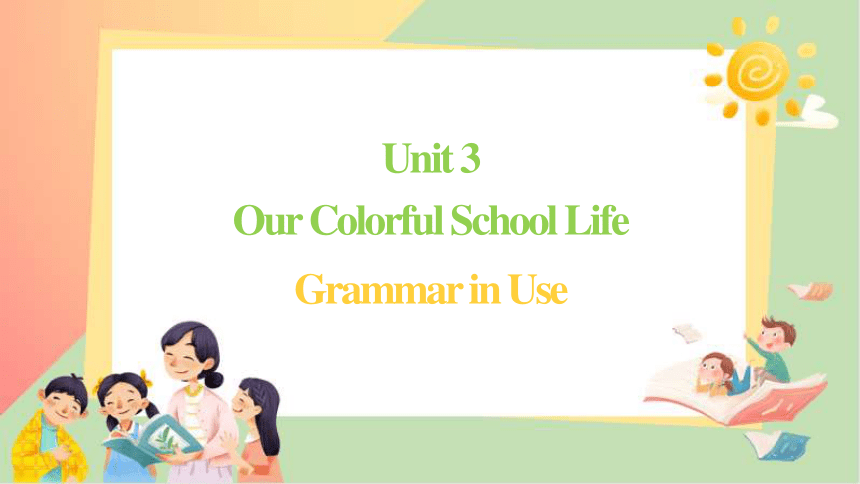 | |
| 格式 | pptx | ||
| 文件大小 | 17.4MB | ||
| 资源类型 | 教案 | ||
| 版本资源 | 仁爱科普版 | ||
| 科目 | 英语 | ||
| 更新时间 | 2024-10-30 08:58:09 | ||
图片预览

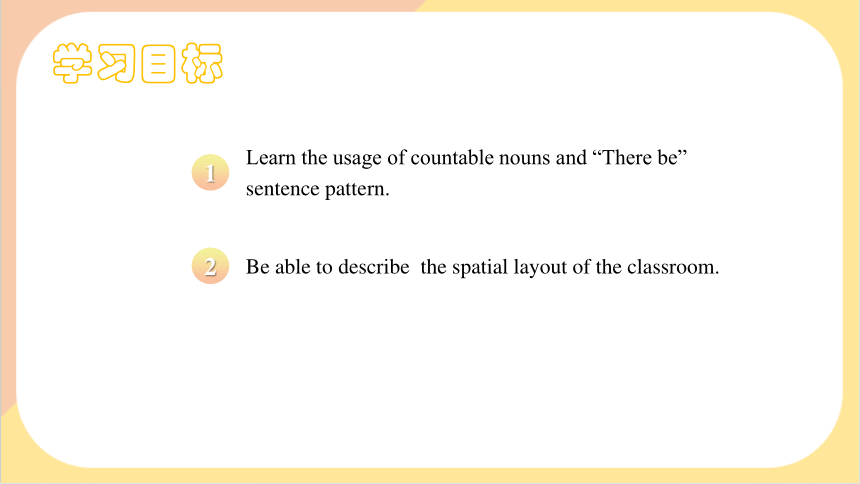


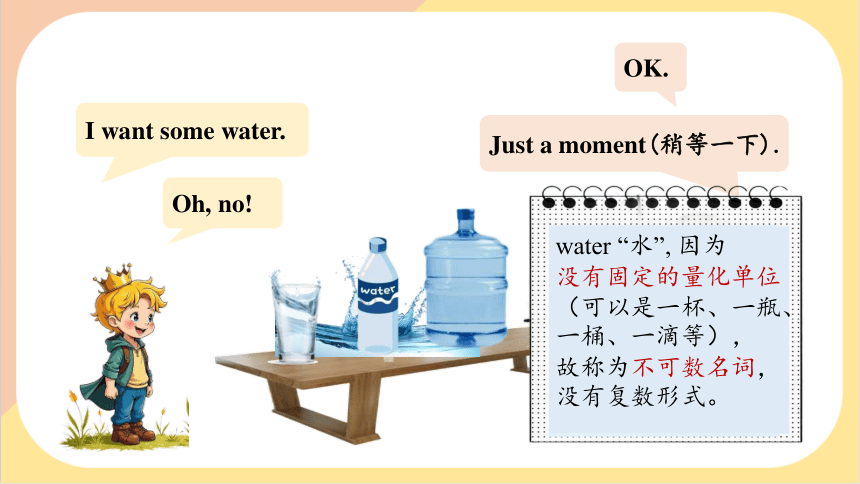

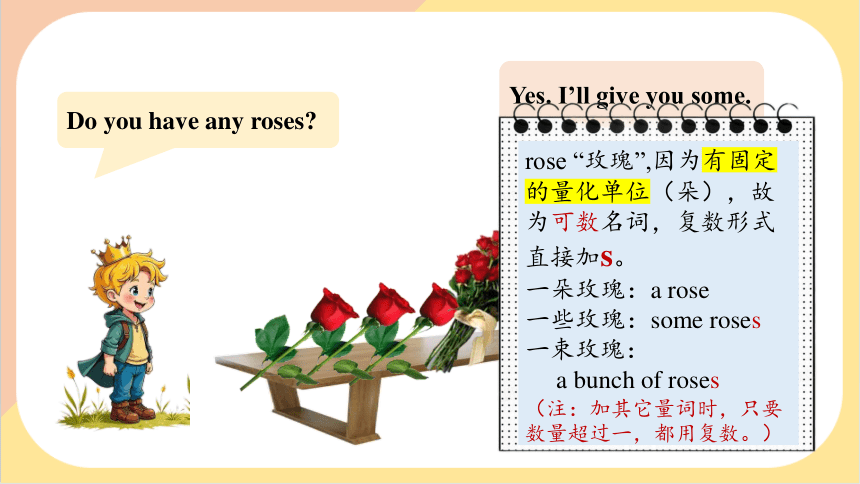
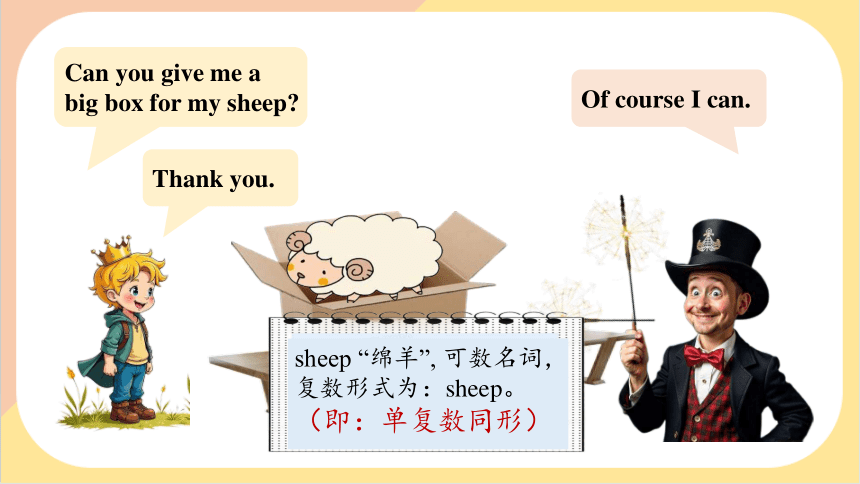

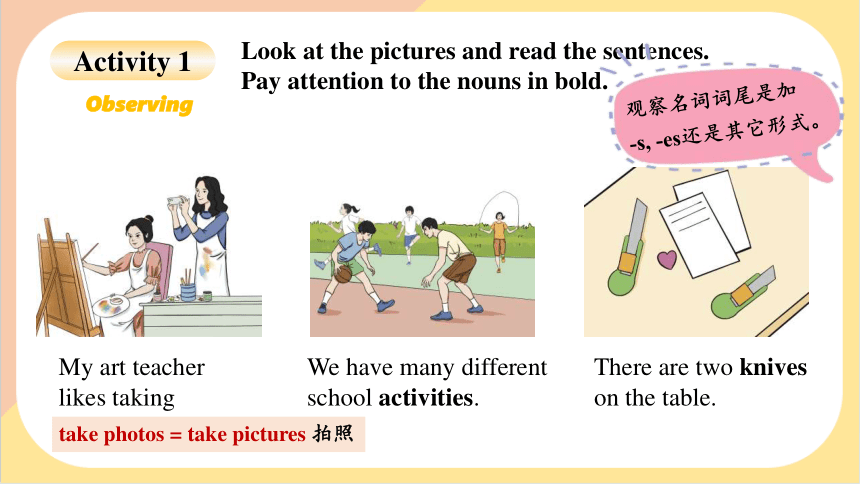
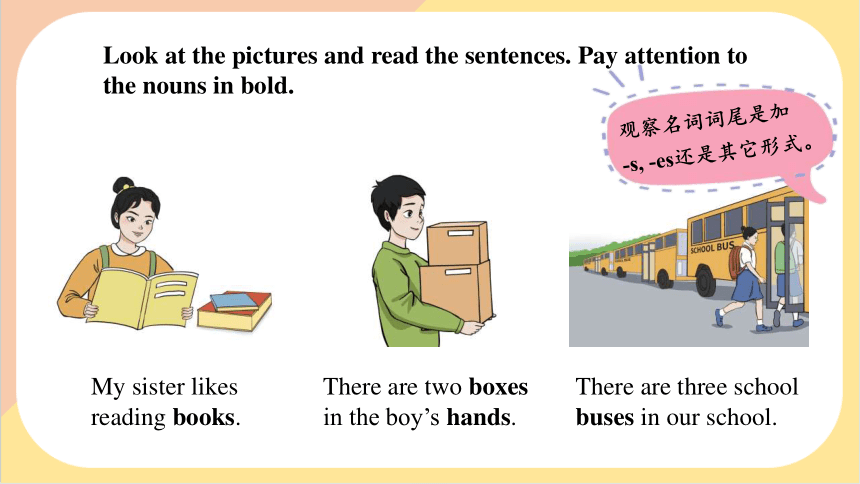
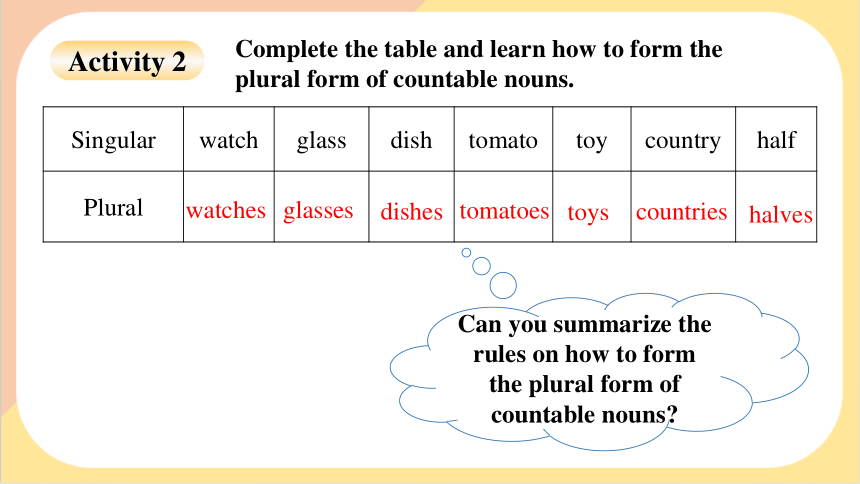
文档简介
(共38张PPT)
Unit 3
Our Colorful School Life
Grammar in Use
学习目标
2
Be able to describe the spatial layout of the classroom.
1
Learn the usage of countable nouns and “There be” sentence pattern.
The Little Prince from outer space is full of curiosity about everything on Earth.
来自外太空的小王子对地球上的一切都充满了好奇。
He met a magician.
他遇到了一个魔法师。
新课讲授
Hi! Do you have any money
Of course. I’ll show you some.(当然,我给你看一些).
Let me count(数一数).
One, two, three, four, five moneys.
Oh, no!
money “钱”, 因为没有固定的量化单位(可以是分、角、元、百元、千元等),故称为不可数名词,不能加s。
此处可以表达为:5 yuan。
(注:yuan “元”,凡是用汉语拼音拼出来的词都没有复数形式。)
I want some water.
OK.
Oh, no!
Just a moment(稍等一下).
water “水”, 因为
没有固定的量化单位(可以是一杯、一瓶、一桶、一滴等),
故称为不可数名词,没有复数形式。
I want some bread.
Just a moment(稍等一下).
bread “面包”, 面包的形态不一,量词也不固定。为不可数名词,没有复数形式。
在西方文化中,面包是主食,人们通常不会将其分割成单个单位进行计数。在提及面包时,人们更关注其总量而
非具体数量。
Do you have any roses
Yes. I’ll give you some.
rose “玫瑰”,因为有固定的量化单位(朵),故为可数名词,复数形式直接加s。
一朵玫瑰:a rose
一些玫瑰:some roses
一束玫瑰:
a bunch of roses
(注:加其它量词时,只要数量超过一,都用复数。)
Can you give me a big box for my sheep
Of course I can.
sheep “绵羊”, 可数名词,复数形式为:sheep。
(即:单复数同形)
Thank you.
名词的数:可数名词
不可数名词
(名词是否可数的本质:不是“可不可以去数”,而是看它”是否有一个相对固定的量化单位。)
例如:“钱”、“时间”、“水” ,都没有固定的量化单位,称为不可数名词。
椅子(把)、车(辆)、书(本),有固定的量化单位,称为可数名词。
名词是表示人、事物、地点或抽象概念的词。缩写为n.
例如: baby 婴儿 pencil 铅笔 Shanghai 上海 air 空气
Countable nouns 可数名词
Summary
Look at the pictures and read the sentences. Pay attention to the nouns in bold.
My art teacher likes taking photos.
We have many different school activities.
There are two knives on the table.
Observing
观察名词词尾是加
-s, -es还是其它形式。
take photos = take pictures 拍照
Activity 1
Look at the pictures and read the sentences. Pay attention to the nouns in bold.
My sister likes reading books.
There are two boxes in the boy’s hands.
There are three school buses in our school.
观察名词词尾是加
-s, -es还是其它形式。
Complete the table and learn how to form the plural form of countable nouns.
Singular watch glass dish tomato toy country half
Plural
watches
glasses
dishes
tomatoes
toys
countries
halves
Can you summarize the rules on how to form the plural form of countable nouns
Activity 2
1) 可数名词单数变复数的规则变化如下表:
类别 规则 示例
一般情况 词尾加-s cat→ cats friend→ friends
以s、x、ch、sh结尾 词尾加-es glass→ glasses box→ boxes
watch→ watches brush→ brushes
以f或fe结尾 变f 或fe为v,再加-es shelf→ shelves knife→ knives
直接加-s roof→ roofs 屋顶
以辅音字母加y结尾 变y为i,再加-es country→ countries baby→ babies
以o结尾 表示有生命的词尾加-es (口诀:黑人英雄爱吃土豆和西红柿) Negro→ Negroes 黑人
hero → heroes 英雄
potato→potatoes tomato→ tomatoes
表示无生命的词尾加-s photo→ photos piano → pianos
radio→ radios 收音机
zoo→ zoos 动物园
Summary
2) 可数名词单数变复数的不规则变化如下表:
规则 示例
单复数同形 Chinese → Chinese 中国人
Japanese → Japanese 日本人
deer→ deer 鹿
sheep→ sheep 绵羊
改变单数名词中的元音字母 foot→ feet 脚
tooth→ teeth 牙齿
goose→ geese 鹅
man→ men
woman→ women
其他形式 child→children mouse → mice 老鼠
3) 可数名词的用法:
冠词 可用不定冠词a/an修饰。例如:
a school一所学校 an activity 一项活动
修饰词 可用some/any、many修饰或“数词+(量词)+of”结构来修饰。如:
three apples 三个苹果 three boxes of apples 三箱苹果
主谓一致 如果是单数名词作主语,则谓语动词用单数,如果是复数名词作主语,谓语动词用复数。例如:
The student is/comes from America. 这个学生来自美国。
These students are/come from America.这些学生来自美国。
提问数量 用“How many+可数名词复数.”。例如:
—How many bananas are there 有多少香蕉?
—Three. 三个。(注:不可数名词用How much提问数量。)
思考:怎样区分用a/an来修饰单数可数名词呢?
______ knife
______ box
______ photo
______ club
______ friend
______ country
______ U
______ apple
______ eraser
______ orange
______ umbrella(伞)
_______ activity
______ S
_______ A
a
an
用a/an填空,并总结其规则。
______ apple
______ eraser
______ orange
______ umbrella(伞)
_______ activity
______ S
_______ A
______ knife
______ box
______ photo
______ club
______ friend
______ country
______ U
写出首字母的第一个音素(音标)
/ /
/ /
/ /
/ /
/ /
/e/
/e /
以元音音素开头的单词或字母
/n/
/b/
/f/
/k/
/f/
/k/
/j(u:)/
以辅音音素开头的单词或字母
小鸡回家。
bottle
a
an
desk
egg
cat
watch
eraser
chair
orange
Read the text and tick ( √ ) the correct words.
Mike is an American boy. At an American school, (student/students)
meet their class teacher at the start of the (day/days). During the day,
they go to different (classroom/ classrooms) for different subjects.
After school. they take part in the club (activity/activities). Mike is
in the science (club/clubs). At the club, he makes (friends/friend) with
students from America and other (country/countries).
Can you discuss about different school lives in different cultures
at the start (of...) 在......的开始
take part in 和 be in 都意为“参加”,
可互换。表示参加小规模的活动,
如:比赛、游戏等,还可与join in互换。
Activity 3
I have three new _________ (T-shirt).
There are 9 ________ (dish) on the table.
There are two _________ (library) in our school.
My sister likes eating __________ (tomato).
T-shirts
libraries
dishes
tomatoes
Let’s practice
My father raises three _________ (sheep).
Tom’s uncle has four ___________ (child).
There are two _________ (knife) on the desk.
There are different kinds of
__________ (fish) in the river.
sheep
knives
children
fishes
There be... There be句型
概述:
There be句型常见的结构为:
“There be + 主语 + 地点状语”,
表示“某地有某物/某人”,其中there本身无词义,
be为谓语,There be后面的名词为句子的主语。
There _______ 5 yuan on the table.
用is/are填空,并总结其用法。
is
There _______ 4 bananas on the table.
are
There be句型的肯定句:
There _____ + 不可数名词/可数名词单数+地点状语;
There _____ + 可数名词复数+地点状语。
is
are
让我来考考你!
There _______ some water in the bottle.
is
There _______ no water in the bottle.
is
= There is not any water in
the bottle.
There be句型的否定句:
There is + no + 不可数名词+地点状语;
= There is + _____ _____ + 不可数名词+地点状语。
not any
让我来考考你!
用is/are填空,并总结其用法。
用is/are填空,并总结其用法。
There _______ a pencil in pencil-box.
is
There _______ no pencil in the pencil-box.
is
= There is not a pencil in
the pencil-box.
There be句型的否定句:
There is + no + 可数名词单数+地点状语;
= There is + _____ ______ + 可数名词单数+地点状语。
not a/an
让我来考考你!
用is/are填空,并总结其用法。
There _______ some apples in the basket.
are
There _______ no apples in the basket.
are
= There are not any apples in
the basket.
There be句型的否定句:
There are + no + 可数名词复数+地点状语;
= There are + _____ _____ + 可数名词复数+地点状语。
not any
让我来考考你!
让我来考考你!
进行肯定/否定回答,并总结规则。
Is there an eraser on the table
Yes, there _______.
Oh, no! There is a knife.
is
让我来考考你!
进行肯定/否定回答,并总结规则。
Are there any books on the table
No, there _______.
Oh, there are some books.
aren’t
There be句型的一般疑问句:
Be + there + 主语 + 地点状语?
答语:—Yes, there be (is/are).
—No, there be (is/are) not.。
Pair work. Read the conversation. Pay attention to there be.
What’s in the big box
There are some bottles in it.
Is there any water in the bottles
No, there isn’t. But there is some juice.
Are there any toys in the small boxes
Yes, there are.
Activity 1
1. —What’s in the big box 这个大箱子里有什么?
—There are some bottles in it. 里面有一些瓶子。
“What's+介词短语?”是一个询问某地/某物有什么的句型,
其答语: 常用There be句型来回答或可直接回答是什么。
E.g. —What's in your schoolbag 你书包里有什么?
—There are some books./Some books. 有一些书。/一些书。
练习: — _______ in today’s newspaper
— There’s nothing interesting. It’s boring.
A. Where B. What C. What’s D. How’s
A
Language points
2. —Is there any water in the bottles 瓶子里有一些水吗?
—No, there isn’t. But there is some juice. 不,没有。但是有一些果汁。
any 表示“一些”时,主要用于否定句和疑问句中,用以代替some, 此时any一般用来修饰不可数名词或可数名词复数。
辨析: some和any
e.g. There are some books on the desk. 桌子上有一些书。
Would you like singing some songs with me 你愿意和我一起唱歌吗?
练习:—Is there ______ water in the bottle — Yes, there is. But it’s too hot.
A. some B. a C. an D. any
单词 用法
any “任何一个;一些”,常用在否定句和疑问句中,其后跟可数名词复数或不可数名词。
some “一些”,一般用在肯定句中。some有时也可以用于表示客气请求的疑问句中,希望得到对方肯定的回答。
D
Complete the table and learn how to use there be.
Singular noun Plural noun
Positive There ______ (There’s) ... There _______ (There’re) ...
Negative There _______ (There isn’t) ... There ________ (There aren’t) ...
Question _______ there a/an/any ... _______ there any ...
Short answer Yes, there _______. Yes, there _______.
No, there ______. No, there _______.
is
is not
Is
is
isn’t
are
are not
Are
are
aren’t
Activity 2
句式 结构
肯定句 There be + 主语 (a/an+可数名词的单数/不可数名词/不定代词) + 地点状语
There be + 主语 (可数名词复数) + 地点状语
否定句 There be + not + 主语 + 地点状语
一般疑问句 —Be + there + 主语 + 地点状语?
—Yes, there be.
—No, there be not.
特殊疑问句 特殊疑问词 + 主语 + be + there + 地点状语?
There be...
Summary
拓展:
1. There be与have/has的区别:
There be表示“在某地有某人/某物”;have/has 表示“某人拥有某物”。
但是要注意的是,There have/has 这一表达是错误的。
E.g. I have a bag. There are many pencils in the bag. 我有一个包。包里有很多铅笔。
2. there be句型主语部分有多个名词并列时,be动词要与邻近的主语保持一致,
即就近原则。
E.g. There _______ a box and two knives on the table. 桌子上有两把刀和一个箱子。
There ________ two knives and a box on the table. 桌子上有一个箱子和两把刀。
is
are
Look at the picture of a classroom, and then follow the example to ask and answer questions with there be.
Example:
— What’s in the classroom
— There is a blackboard and some desks.
— Are there any chairs in the classroom
— Yes, there are.
Activity 3
Describe the picture with there be and countable nouns.
There is a football under the window.
There is a box near the door.
There are some books and
a schoolbag on the desk.
There are two ping-pong bats on the desk.
Is there a book and a pen
We learn:
1. how to form the plural form of countable nouns.
2. the usage of “there be”.
We can:
use “There be + …”to describe something.
课堂总结
I. 选择题。
1. There ______ many knives in the box.
A. are B. is C. have D. has
2. There is some ________ in the bottle.
A. tomatoes B. toys C. juice D. flowers
3. —________ is on the table —There are a lot of photo on it.
A. How B. What C. Which D. Who
4. —Are there any bananas on the table
—________. And there are some apples, too.
A.Yes, there is B.No, there aren't C.Yes, there are D.No, there isn't
5. —________ eggs do you want —Eight, please.
A.How many B.How much C.How old D.What colour
A
C
B
C
A
当堂检测
II. 用括号内所给词的适当形式填空。
1. There are more ________ (tree) on both sides of the street.
2. My granny has a few bad ________ (tooth).
She can’t eat such hard food.
3. Students can receive national defense education by listening to
some battle ________ (story).
4. There are many ________ (deer) and ________ (sheep) on the grass.
5. I buy two _____________ (scarf 围巾) for my mother as her birthday
present.
trees
teeth
stories
deer
sheep
scarves/scarfs
Unit 3
Our Colorful School Life
Grammar in Use
学习目标
2
Be able to describe the spatial layout of the classroom.
1
Learn the usage of countable nouns and “There be” sentence pattern.
The Little Prince from outer space is full of curiosity about everything on Earth.
来自外太空的小王子对地球上的一切都充满了好奇。
He met a magician.
他遇到了一个魔法师。
新课讲授
Hi! Do you have any money
Of course. I’ll show you some.(当然,我给你看一些).
Let me count(数一数).
One, two, three, four, five moneys.
Oh, no!
money “钱”, 因为没有固定的量化单位(可以是分、角、元、百元、千元等),故称为不可数名词,不能加s。
此处可以表达为:5 yuan。
(注:yuan “元”,凡是用汉语拼音拼出来的词都没有复数形式。)
I want some water.
OK.
Oh, no!
Just a moment(稍等一下).
water “水”, 因为
没有固定的量化单位(可以是一杯、一瓶、一桶、一滴等),
故称为不可数名词,没有复数形式。
I want some bread.
Just a moment(稍等一下).
bread “面包”, 面包的形态不一,量词也不固定。为不可数名词,没有复数形式。
在西方文化中,面包是主食,人们通常不会将其分割成单个单位进行计数。在提及面包时,人们更关注其总量而
非具体数量。
Do you have any roses
Yes. I’ll give you some.
rose “玫瑰”,因为有固定的量化单位(朵),故为可数名词,复数形式直接加s。
一朵玫瑰:a rose
一些玫瑰:some roses
一束玫瑰:
a bunch of roses
(注:加其它量词时,只要数量超过一,都用复数。)
Can you give me a big box for my sheep
Of course I can.
sheep “绵羊”, 可数名词,复数形式为:sheep。
(即:单复数同形)
Thank you.
名词的数:可数名词
不可数名词
(名词是否可数的本质:不是“可不可以去数”,而是看它”是否有一个相对固定的量化单位。)
例如:“钱”、“时间”、“水” ,都没有固定的量化单位,称为不可数名词。
椅子(把)、车(辆)、书(本),有固定的量化单位,称为可数名词。
名词是表示人、事物、地点或抽象概念的词。缩写为n.
例如: baby 婴儿 pencil 铅笔 Shanghai 上海 air 空气
Countable nouns 可数名词
Summary
Look at the pictures and read the sentences. Pay attention to the nouns in bold.
My art teacher likes taking photos.
We have many different school activities.
There are two knives on the table.
Observing
观察名词词尾是加
-s, -es还是其它形式。
take photos = take pictures 拍照
Activity 1
Look at the pictures and read the sentences. Pay attention to the nouns in bold.
My sister likes reading books.
There are two boxes in the boy’s hands.
There are three school buses in our school.
观察名词词尾是加
-s, -es还是其它形式。
Complete the table and learn how to form the plural form of countable nouns.
Singular watch glass dish tomato toy country half
Plural
watches
glasses
dishes
tomatoes
toys
countries
halves
Can you summarize the rules on how to form the plural form of countable nouns
Activity 2
1) 可数名词单数变复数的规则变化如下表:
类别 规则 示例
一般情况 词尾加-s cat→ cats friend→ friends
以s、x、ch、sh结尾 词尾加-es glass→ glasses box→ boxes
watch→ watches brush→ brushes
以f或fe结尾 变f 或fe为v,再加-es shelf→ shelves knife→ knives
直接加-s roof→ roofs 屋顶
以辅音字母加y结尾 变y为i,再加-es country→ countries baby→ babies
以o结尾 表示有生命的词尾加-es (口诀:黑人英雄爱吃土豆和西红柿) Negro→ Negroes 黑人
hero → heroes 英雄
potato→potatoes tomato→ tomatoes
表示无生命的词尾加-s photo→ photos piano → pianos
radio→ radios 收音机
zoo→ zoos 动物园
Summary
2) 可数名词单数变复数的不规则变化如下表:
规则 示例
单复数同形 Chinese → Chinese 中国人
Japanese → Japanese 日本人
deer→ deer 鹿
sheep→ sheep 绵羊
改变单数名词中的元音字母 foot→ feet 脚
tooth→ teeth 牙齿
goose→ geese 鹅
man→ men
woman→ women
其他形式 child→children mouse → mice 老鼠
3) 可数名词的用法:
冠词 可用不定冠词a/an修饰。例如:
a school一所学校 an activity 一项活动
修饰词 可用some/any、many修饰或“数词+(量词)+of”结构来修饰。如:
three apples 三个苹果 three boxes of apples 三箱苹果
主谓一致 如果是单数名词作主语,则谓语动词用单数,如果是复数名词作主语,谓语动词用复数。例如:
The student is/comes from America. 这个学生来自美国。
These students are/come from America.这些学生来自美国。
提问数量 用“How many+可数名词复数.”。例如:
—How many bananas are there 有多少香蕉?
—Three. 三个。(注:不可数名词用How much提问数量。)
思考:怎样区分用a/an来修饰单数可数名词呢?
______ knife
______ box
______ photo
______ club
______ friend
______ country
______ U
______ apple
______ eraser
______ orange
______ umbrella(伞)
_______ activity
______ S
_______ A
a
an
用a/an填空,并总结其规则。
______ apple
______ eraser
______ orange
______ umbrella(伞)
_______ activity
______ S
_______ A
______ knife
______ box
______ photo
______ club
______ friend
______ country
______ U
写出首字母的第一个音素(音标)
/ /
/ /
/ /
/ /
/ /
/e/
/e /
以元音音素开头的单词或字母
/n/
/b/
/f/
/k/
/f/
/k/
/j(u:)/
以辅音音素开头的单词或字母
小鸡回家。
bottle
a
an
desk
egg
cat
watch
eraser
chair
orange
Read the text and tick ( √ ) the correct words.
Mike is an American boy. At an American school, (student/students)
meet their class teacher at the start of the (day/days). During the day,
they go to different (classroom/ classrooms) for different subjects.
After school. they take part in the club (activity/activities). Mike is
in the science (club/clubs). At the club, he makes (friends/friend) with
students from America and other (country/countries).
Can you discuss about different school lives in different cultures
at the start (of...) 在......的开始
take part in 和 be in 都意为“参加”,
可互换。表示参加小规模的活动,
如:比赛、游戏等,还可与join in互换。
Activity 3
I have three new _________ (T-shirt).
There are 9 ________ (dish) on the table.
There are two _________ (library) in our school.
My sister likes eating __________ (tomato).
T-shirts
libraries
dishes
tomatoes
Let’s practice
My father raises three _________ (sheep).
Tom’s uncle has four ___________ (child).
There are two _________ (knife) on the desk.
There are different kinds of
__________ (fish) in the river.
sheep
knives
children
fishes
There be... There be句型
概述:
There be句型常见的结构为:
“There be + 主语 + 地点状语”,
表示“某地有某物/某人”,其中there本身无词义,
be为谓语,There be后面的名词为句子的主语。
There _______ 5 yuan on the table.
用is/are填空,并总结其用法。
is
There _______ 4 bananas on the table.
are
There be句型的肯定句:
There _____ + 不可数名词/可数名词单数+地点状语;
There _____ + 可数名词复数+地点状语。
is
are
让我来考考你!
There _______ some water in the bottle.
is
There _______ no water in the bottle.
is
= There is not any water in
the bottle.
There be句型的否定句:
There is + no + 不可数名词+地点状语;
= There is + _____ _____ + 不可数名词+地点状语。
not any
让我来考考你!
用is/are填空,并总结其用法。
用is/are填空,并总结其用法。
There _______ a pencil in pencil-box.
is
There _______ no pencil in the pencil-box.
is
= There is not a pencil in
the pencil-box.
There be句型的否定句:
There is + no + 可数名词单数+地点状语;
= There is + _____ ______ + 可数名词单数+地点状语。
not a/an
让我来考考你!
用is/are填空,并总结其用法。
There _______ some apples in the basket.
are
There _______ no apples in the basket.
are
= There are not any apples in
the basket.
There be句型的否定句:
There are + no + 可数名词复数+地点状语;
= There are + _____ _____ + 可数名词复数+地点状语。
not any
让我来考考你!
让我来考考你!
进行肯定/否定回答,并总结规则。
Is there an eraser on the table
Yes, there _______.
Oh, no! There is a knife.
is
让我来考考你!
进行肯定/否定回答,并总结规则。
Are there any books on the table
No, there _______.
Oh, there are some books.
aren’t
There be句型的一般疑问句:
Be + there + 主语 + 地点状语?
答语:—Yes, there be (is/are).
—No, there be (is/are) not.。
Pair work. Read the conversation. Pay attention to there be.
What’s in the big box
There are some bottles in it.
Is there any water in the bottles
No, there isn’t. But there is some juice.
Are there any toys in the small boxes
Yes, there are.
Activity 1
1. —What’s in the big box 这个大箱子里有什么?
—There are some bottles in it. 里面有一些瓶子。
“What's+介词短语?”是一个询问某地/某物有什么的句型,
其答语: 常用There be句型来回答或可直接回答是什么。
E.g. —What's in your schoolbag 你书包里有什么?
—There are some books./Some books. 有一些书。/一些书。
练习: — _______ in today’s newspaper
— There’s nothing interesting. It’s boring.
A. Where B. What C. What’s D. How’s
A
Language points
2. —Is there any water in the bottles 瓶子里有一些水吗?
—No, there isn’t. But there is some juice. 不,没有。但是有一些果汁。
any 表示“一些”时,主要用于否定句和疑问句中,用以代替some, 此时any一般用来修饰不可数名词或可数名词复数。
辨析: some和any
e.g. There are some books on the desk. 桌子上有一些书。
Would you like singing some songs with me 你愿意和我一起唱歌吗?
练习:—Is there ______ water in the bottle — Yes, there is. But it’s too hot.
A. some B. a C. an D. any
单词 用法
any “任何一个;一些”,常用在否定句和疑问句中,其后跟可数名词复数或不可数名词。
some “一些”,一般用在肯定句中。some有时也可以用于表示客气请求的疑问句中,希望得到对方肯定的回答。
D
Complete the table and learn how to use there be.
Singular noun Plural noun
Positive There ______ (There’s) ... There _______ (There’re) ...
Negative There _______ (There isn’t) ... There ________ (There aren’t) ...
Question _______ there a/an/any ... _______ there any ...
Short answer Yes, there _______. Yes, there _______.
No, there ______. No, there _______.
is
is not
Is
is
isn’t
are
are not
Are
are
aren’t
Activity 2
句式 结构
肯定句 There be + 主语 (a/an+可数名词的单数/不可数名词/不定代词) + 地点状语
There be + 主语 (可数名词复数) + 地点状语
否定句 There be + not + 主语 + 地点状语
一般疑问句 —Be + there + 主语 + 地点状语?
—Yes, there be.
—No, there be not.
特殊疑问句 特殊疑问词 + 主语 + be + there + 地点状语?
There be...
Summary
拓展:
1. There be与have/has的区别:
There be表示“在某地有某人/某物”;have/has 表示“某人拥有某物”。
但是要注意的是,There have/has 这一表达是错误的。
E.g. I have a bag. There are many pencils in the bag. 我有一个包。包里有很多铅笔。
2. there be句型主语部分有多个名词并列时,be动词要与邻近的主语保持一致,
即就近原则。
E.g. There _______ a box and two knives on the table. 桌子上有两把刀和一个箱子。
There ________ two knives and a box on the table. 桌子上有一个箱子和两把刀。
is
are
Look at the picture of a classroom, and then follow the example to ask and answer questions with there be.
Example:
— What’s in the classroom
— There is a blackboard and some desks.
— Are there any chairs in the classroom
— Yes, there are.
Activity 3
Describe the picture with there be and countable nouns.
There is a football under the window.
There is a box near the door.
There are some books and
a schoolbag on the desk.
There are two ping-pong bats on the desk.
Is there a book and a pen
We learn:
1. how to form the plural form of countable nouns.
2. the usage of “there be”.
We can:
use “There be + …”to describe something.
课堂总结
I. 选择题。
1. There ______ many knives in the box.
A. are B. is C. have D. has
2. There is some ________ in the bottle.
A. tomatoes B. toys C. juice D. flowers
3. —________ is on the table —There are a lot of photo on it.
A. How B. What C. Which D. Who
4. —Are there any bananas on the table
—________. And there are some apples, too.
A.Yes, there is B.No, there aren't C.Yes, there are D.No, there isn't
5. —________ eggs do you want —Eight, please.
A.How many B.How much C.How old D.What colour
A
C
B
C
A
当堂检测
II. 用括号内所给词的适当形式填空。
1. There are more ________ (tree) on both sides of the street.
2. My granny has a few bad ________ (tooth).
She can’t eat such hard food.
3. Students can receive national defense education by listening to
some battle ________ (story).
4. There are many ________ (deer) and ________ (sheep) on the grass.
5. I buy two _____________ (scarf 围巾) for my mother as her birthday
present.
trees
teeth
stories
deer
sheep
scarves/scarfs
同课章节目录
